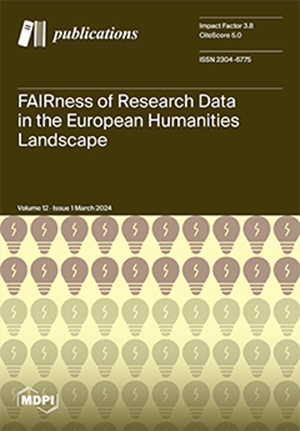求助PDF
{"title":"应用 GFsa(GF \"科学时代\")指数评估 1020 名牙科高被引研究人员:比较 GFsa 指数和 H 指数的试点研究","authors":"G. Fernandes, Juliana Campos Hasse Fernandes","doi":"10.3390/publications12020018","DOIUrl":null,"url":null,"abstract":"Objective: The goal of this pilot study was to present a new index system (GFsa©) based on two variables, the total citations and “scientific age”, to evaluate the best-ranked researchers in dentistry. Methods: All researchers included were cited in the AD Scientific Index (2024, dentistry field) and had their Google Scholar page accessible for a manual consultation. Two authors retrieved this information. A dataset was prepared (name, H-index, i10 index, and publications). The formula applied was GFsa = (total number of citations)/(“scientific age”)2. The Pearson correlation statistically evaluated the data obtained; the confidence interval was 95%. Results: A total of 1020 were included. The mean “scientific age” was 34.18 ± 13.34. The GFsa© index was calculated, presenting a minimum value of 0.2186 and a maximum of 154.8. The data were organized and sorted following the ranking obtained. The Pearson correlation showed that the H-index had a weakly positive association with the researcher’s “scientific age”; thus, the H-index increased according to the increase in “scientific age”. By contrast, a moderately negative correlation between GFsa and “scientific age” was demonstrated. Moreover, a positive correlation was observed between both indexes. Conclusions: The variable reported (“Scientific age”) provided a better evaluation among the researchers in dentistry.","PeriodicalId":37551,"journal":{"name":"Publications","volume":null,"pages":null},"PeriodicalIF":4.6000,"publicationDate":"2024-06-10","publicationTypes":"Journal Article","fieldsOfStudy":null,"isOpenAccess":false,"openAccessPdf":"","citationCount":"0","resultStr":"{\"title\":\"GFsa (GF “Scientific Age”) Index Application for Assessment of 1020 Highly Cited Researchers in Dentistry: A Pilot Study Comparing GFsa Index and H-Index\",\"authors\":\"G. Fernandes, Juliana Campos Hasse Fernandes\",\"doi\":\"10.3390/publications12020018\",\"DOIUrl\":null,\"url\":null,\"abstract\":\"Objective: The goal of this pilot study was to present a new index system (GFsa©) based on two variables, the total citations and “scientific age”, to evaluate the best-ranked researchers in dentistry. Methods: All researchers included were cited in the AD Scientific Index (2024, dentistry field) and had their Google Scholar page accessible for a manual consultation. Two authors retrieved this information. A dataset was prepared (name, H-index, i10 index, and publications). The formula applied was GFsa = (total number of citations)/(“scientific age”)2. The Pearson correlation statistically evaluated the data obtained; the confidence interval was 95%. Results: A total of 1020 were included. The mean “scientific age” was 34.18 ± 13.34. The GFsa© index was calculated, presenting a minimum value of 0.2186 and a maximum of 154.8. The data were organized and sorted following the ranking obtained. The Pearson correlation showed that the H-index had a weakly positive association with the researcher’s “scientific age”; thus, the H-index increased according to the increase in “scientific age”. By contrast, a moderately negative correlation between GFsa and “scientific age” was demonstrated. Moreover, a positive correlation was observed between both indexes. Conclusions: The variable reported (“Scientific age”) provided a better evaluation among the researchers in dentistry.\",\"PeriodicalId\":37551,\"journal\":{\"name\":\"Publications\",\"volume\":null,\"pages\":null},\"PeriodicalIF\":4.6000,\"publicationDate\":\"2024-06-10\",\"publicationTypes\":\"Journal Article\",\"fieldsOfStudy\":null,\"isOpenAccess\":false,\"openAccessPdf\":\"\",\"citationCount\":\"0\",\"resultStr\":null,\"platform\":\"Semanticscholar\",\"paperid\":null,\"PeriodicalName\":\"Publications\",\"FirstCategoryId\":\"1085\",\"ListUrlMain\":\"https://doi.org/10.3390/publications12020018\",\"RegionNum\":0,\"RegionCategory\":null,\"ArticlePicture\":[],\"TitleCN\":null,\"AbstractTextCN\":null,\"PMCID\":null,\"EPubDate\":\"\",\"PubModel\":\"\",\"JCR\":\"Q1\",\"JCRName\":\"INFORMATION SCIENCE & LIBRARY SCIENCE\",\"Score\":null,\"Total\":0}","platform":"Semanticscholar","paperid":null,"PeriodicalName":"Publications","FirstCategoryId":"1085","ListUrlMain":"https://doi.org/10.3390/publications12020018","RegionNum":0,"RegionCategory":null,"ArticlePicture":[],"TitleCN":null,"AbstractTextCN":null,"PMCID":null,"EPubDate":"","PubModel":"","JCR":"Q1","JCRName":"INFORMATION SCIENCE & LIBRARY SCIENCE","Score":null,"Total":0}
引用次数: 0
引用
批量引用
GFsa (GF “Scientific Age”) Index Application for Assessment of 1020 Highly Cited Researchers in Dentistry: A Pilot Study Comparing GFsa Index and H-Index
Objective: The goal of this pilot study was to present a new index system (GFsa©) based on two variables, the total citations and “scientific age”, to evaluate the best-ranked researchers in dentistry. Methods: All researchers included were cited in the AD Scientific Index (2024, dentistry field) and had their Google Scholar page accessible for a manual consultation. Two authors retrieved this information. A dataset was prepared (name, H-index, i10 index, and publications). The formula applied was GFsa = (total number of citations)/(“scientific age”)2. The Pearson correlation statistically evaluated the data obtained; the confidence interval was 95%. Results: A total of 1020 were included. The mean “scientific age” was 34.18 ± 13.34. The GFsa© index was calculated, presenting a minimum value of 0.2186 and a maximum of 154.8. The data were organized and sorted following the ranking obtained. The Pearson correlation showed that the H-index had a weakly positive association with the researcher’s “scientific age”; thus, the H-index increased according to the increase in “scientific age”. By contrast, a moderately negative correlation between GFsa and “scientific age” was demonstrated. Moreover, a positive correlation was observed between both indexes. Conclusions: The variable reported (“Scientific age”) provided a better evaluation among the researchers in dentistry.


